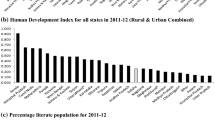Abstract
We investigate how natural disaster damages affect regional economic growth and their spatial spillover effect in various human development (HDI) level settings by utilising a panel annual district-level dataset from Indonesia. We employ Spatial Durbin Model to achieve these objectives. We find that disaster damage to houses has a negative effect on district-level per capita output growth. Meanwhile, the effect of disaster damage to people on economic growth depends on their HDI level, with low-HDI districts affected negatively and high-HDI districts positively. Our analysis also finds spatial spillover effects on neighbouring regions’ growth, and heterogeneous effects across economic sectors.
Similar content being viewed by others
Data Availability
The datasets generated during and/or analysed during the current study are available in the GitHub repository, https://github.com/soegampars/2022-eaa-isp-disaster.
References
Athukorala, P.C., Resosudarmo, B.P.: The indian ocean tsunami: Economic impact, disaster management, and lessons. Asian Econ. Papers 4(1), 1–39 (2005)
Cavallo, E., Galiani, S., Noy, I., Pantano, J.: Catastrophic natural disasters and economic growth. Rev. Econ. Stat. 95(5), 1549–1561 (2013)
Cunado, J., Ferreira, S.: The macroeconomic impacts of natural disasters: The case of floods. Land Econ. 90(1), 149–168 (2014)
Drabo, A., Mbaye, L.M.: Natural disasters, migration and education: an empirical analysis in developing countries. Environ. Dev. Econ. 20(6), 767–796 (2015). https://doi.org/10.1017/S1355770X14000606
Drukker, D.M., Peng, H., Prucha, I.R., Raciborski, R.: Creating and managing spatial-weighting matrices with the spmat command. Stata J. 13(2), 242–286 (2013). ((45))
duPont, W., IV., Noy, I.: What happened to kobe? a reassessment of the impact of the 1995 earthquake in japan. Econ. Dev. Cult. Change 63(4), 777–812 (2015)
Elhorst, J.P.: Spatial Econometrics from Cross-sectional Data to Spatial Panels. Springer, Berlin (2014)
Felbermayr, G., Gröschl, J.: Naturally negative: The growth effects of natural disasters. J. Dev. Econ. 111, 92–106 (2014)
Fischer, S.: Post-disaster spillovers: Evidence from iranian provinces. J. Risk Finan. Manag. (2021). https://doi.org/10.3390/jrfm14050193
Fomby, T., Ikeda, Y., Loayza, N.V.: The growth aftermath of natural disasters. J. Appl. Economet. 28(3), 412–434 (2013)
Horwich, G.: Economic lessons of the kobe earthquake. Econ. Dev. Cult. Change 48(3), 521–542 (2000)
Klomp, J.: Economic development and natural disasters: A satellite data analysis. Glob. Environ. Chang. 36, 67–88 (2016)
Klomp, J., Valckx, K.: Natural disasters and economic growth: A meta-analysis. Glob. Environ. Chang. 26, 183–195 (2014)
Kunreuther, H.: Mitigating disaster losses through insurance. J. Risk Uncertain. 12(2), 171–187 (1996)
Lazzaroni, S., van Bergeijk, P.A.: Natural disasters’ impact, factors of resilience and development: A meta-analysis of the macroeconomic literature. Ecol. Econ. 107, 333–346 (2014)
Leiter, A.M., Oberhofer, H., Raschky, P.A.: Creative disasters? flooding effects on capital, labour and productivity within european firms. Environ. Resource Econ. 43(3), 333–350 (2009)
Lima, R.C.D.A., Barbosa, A.V.B.: Natural disasters, economic growth and spatial spillovers: Evidence from a flash flood in brazil. Pap. Reg. Sci. 98(2), 905–924 (2019)
Loayza, N.V., Olaberria, E., Rigolini, J., Christiaensen, L.: Natural disasters and growth: Going beyond the averages. World Dev. 40(7), 1317–1336 (2012)
Noy, I.: The macroeconomic consequences of disasters. J. Dev. Econ. 88(2), 221–231 (2009)
Noy, I., Vu, T.B.: The economics of natural disasters in a developing country: The case of vietnam. J. Asian Econ. 21(4), 345–354 (2010). https://doi.org/10.1016/j.asieco.2010.03.002
Panwar, V., Sen, S.: Economic impact of natural disasters: An empirical re-examination. Margin J. Appl. Econ. Res. 13(1), 109–139 (2019)
Raddatz, C.E.: The wrath of god: macroeconomic costs of natural disasters. World Bank Policy Research Working Paper (5039) (2009)
Skidmore, M., Toya, H.: Do natural disasters promote long-run growth? Econ. Inq. 40(4), 664–687 (2002)
Strömberg, D.: Natural disasters, economic development, and humanitarian aid. J. Econ. Perspect. 21(3), 199–222 (2007)
Ward, P.S., Shively, G.E.: Disaster risk, social vulnerability, and economic development. Disasters 41(2), 324–351 (2017)
Xiao, Y., Nilawar, U.: Winners and losers: analysing post-disaster spatial economic demand shift. Disasters 37(4), 646–668 (2013)
Author information
Authors and Affiliations
Corresponding author
Ethics declarations
Conflict of interest
The authors have no competing interests to declare that are relevant to the content of this article.
Additional information
Publisher's Note
Springer Nature remains neutral with regard to jurisdictional claims in published maps and institutional affiliations.
Appendices
Appendix A Disaster data summary statistics
See Appendix Table 3.
Appendix B Selection bias test
Selection bias in disaster damage reports might occur when districts with particular characteristics (such as higher level of development) are more likely to report any damages than others. One of the methods of testing this is to check if there exists any correlation between disaster damage reporting probability and district characteristics after controlling for actual disaster intensity (Felbermayr and Gröschl 2014). Because comprehensive district-level disaster intensity data in Indonesia is not available, we use disaster damage in adjacent districts as its proxy. Furthermore, following Felbermayr and Gröschl (2014), we choose GDP per capita (in natural logarithm form) as the district characteristic of interest.
Table 4 presents the estimation result. The dependent variable is a dummy variable which value is 1 if there is any reported disaster damage and 0 if otherwise. There is no correlation between log GDP per capita and damage reporting probability after controlling for the spatial lag of the weighted number of people affected. Thus, we do not find any evidence of selection bias in the DIBI dataset.
Appendix C Variable imputation
We employ linear extrapolation to impute outliers and missing values in variables with the time trend. For those without time trend, we impute them with the median value of the nearest aggregation level available (i.e. using provincial median value, then national median value). We define outliers as any value outside 0 to 100 range for share variables (in %) and outside \(-30\) to 30 for output growth variables (in %). The percentage of imputed observations can be seen in Table 5.
Rights and permissions
About this article
Cite this article
Asyahid, E.A., Pekerti, I.S. Economic impact of natural disasters, spillovers, and role of human development: case of Indonesia. Lett Spat Resour Sci 15, 493–506 (2022). https://doi.org/10.1007/s12076-022-00307-7
Received:
Accepted:
Published:
Issue Date:
DOI: https://doi.org/10.1007/s12076-022-00307-7




